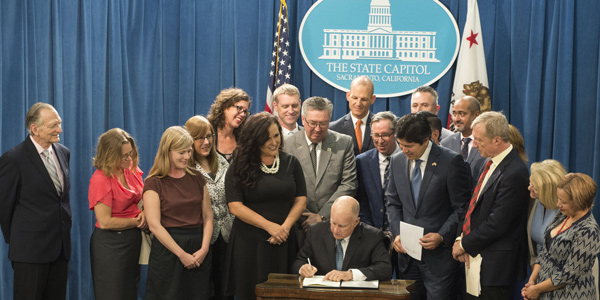By Hudson Sangree
Gov. Jerry Brown on Monday signed legislation requiring California to get 100% of its power from renewable and other zero-carbon resources by 2045. He also issued an executive order for the state to achieve carbon neutrality by the same year.
Brown’s actions came as he readied to host a global climate summit in San Francisco and further positioned himself as a policy counterweight to President Trump, who is seeking to withdraw from the Paris Agreement on climate change and undo EPA’s Clean Power Plan.
“California is committed to doing whatever is necessary to meet the existential threat of climate change,” Brown said in his signing message for SB 100. “This bill, and others I will sign this week, help us go in that direction. But have no illusions, California and the rest of the world have miles to go before we achieve zero-carbon emissions.”
In addition to requiring investor-owned utilities, publicly owned utilities and community choice aggregators to obtain 100% of their energy from renewables by 2045, the new law sets milestones along the way: 40-44% by 2024; 45-52% by 2027; and 50-60% by 2030. (See Calif. Clean Energy Measure Goes to Governor.)
When the law takes effect in January, California will join Hawaii as the second state to declare its intent to rely entirely on renewable resources such as wind, solar and hydropower.
Brown, meanwhile, will take center stage at the Global Climate Action Summit, with its main events happening Sept. 12-14 at San Francisco’s Moscone Center.
The summit will feature civic and industry leaders from around the world discussing topics such as investments in clean energy, the switch to electric vehicles and the health of the planet’s oceans. Portions of the event will stream live on YouTube, Facebook and Twitter.
The summit and SB 100 are part of Brown’s larger push to deal with climate change as he gets ready to leave office at the end of this year.
In his signing message for SB 100, for instance, Brown reiterated his support for a Western RTO. A bill to begin the process of transforming CAISO into an RTO faltered in the State Senate this year. Similar efforts to create an organized market in the West failed in the two prior years as well. (See related story, Western RTO Proponents Vow To Keep Trying.)
“We must join our neighbors in a power system that integrates utilities across the West,” Brown said in the signing message. “A regionalized electric grid would enhance California’s low-carbon grid by allowing us to share renewable resources with our neighboring states, while reducing costs and increasing resiliency of our grid.”



